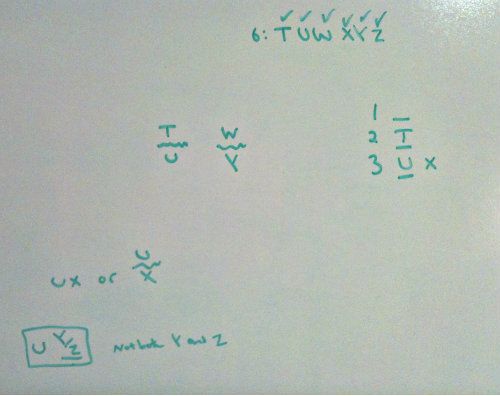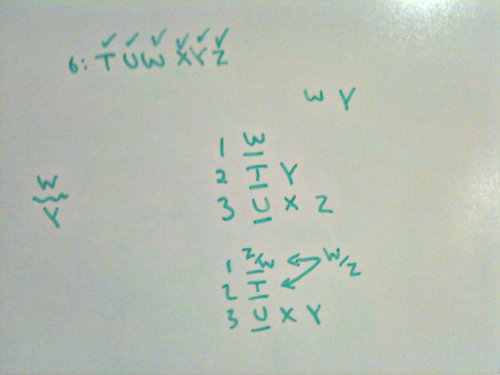I have a question about Q22:
I must be missing something here because i get that all of them cant be true.
I know i am wrong but for argument sake let me tell you what i was thinking:
If T is in second and we know that U<=x, U comes after T then U and X are in the 3rd.
U must equal y or U must equal Z so there must be three in the 3rd.
With the above i dont see how any answer can be right. again i know i must be doing something wrong........but cant see it.
LSAT Forum
5 postsPage 1 of 1
-

- dj_grey
-
Thanks Received: 0
- Forum Guests
- Posts: 29
- Joined: January 30th, 2010

- First Responder
Re: PT 50 g 4 A child eating alphabet soup
ok.......just figured it out.
What i said was correct. However, i see my flaw.
If U=y then w and z are left as possible choices. There is no restriction that w and z cant be together in "1". Thus A.
What i said was correct. However, i see my flaw.
If U=y then w and z are left as possible choices. There is no restriction that w and z cant be together in "1". Thus A.
-

- ManhattanPrepLSAT1
-
Thanks Received: 1909
-
Atticus Finch

- Posts: 2851
- Joined: October 07th, 2009
Re: PT 50 g 4 A child eating alphabet soup
Sometimes you just need a chance to verbalize your thought process. 
-

- timmydoeslsat
-
Thanks Received: 887
-
Atticus Finch

- Posts: 1136
- Joined: June 20th, 2011

- Most Thanked

- First Responder
Re: Q22
Before I explain the way to handle this question, I want to address a a certain question you asked in the post above.
If you are asked for something that could be true and you have an answer choice that must be true, that will be your answer. Something that must be true is something that necessarily could be true. It is could be true on steroids if you will.
I first will post my global diagram of this game. It is a type of game that has come up many times on the recent preptests. It is a type of open assignment game.

With question #22, we have a local question asking what could be true if T is in 2.
We know immediately that U is going to be in 3, as U must always be somewhere behind T, and 3 is the only place it can be to be behind T. At this point, we know that X must be with U in the 3rd row. X is either behind U, which is impossible in this case, or it is beside U.
We also know that exactly 1 of Y/Z is to be beside U. At this point, I know the options are going to be extremely limited, so I will do one hypothetical with the Y there in 3 and then one hypothetical with the Z there in 3.

For the first hypothetical, I have two variables left to be placed, which I make note of in the corner. I have W and Y left to place. I know that someone must go in row 1. It must be W with our sequencing rule. Now Y must go into 2. It cannot be in 3 as we can only have 1 of Y/Z with X into 3.

For the second hypothetical, I have two variables left to be placed. These two are W and Z. Z is free to go into 1 or 2. W can go into either 2 or 3, as its only concern is to be ahead of Y, which it will necessarily be in those spots. So we want to create a dual option of those two variables alternating in row 1 and the opposite of the dual option being able to go in either 1 or 2.
So what could be true? (A) Two variables in row 1.
If you are asked for something that could be true and you have an answer choice that must be true, that will be your answer. Something that must be true is something that necessarily could be true. It is could be true on steroids if you will.
I first will post my global diagram of this game. It is a type of game that has come up many times on the recent preptests. It is a type of open assignment game.

With question #22, we have a local question asking what could be true if T is in 2.
We know immediately that U is going to be in 3, as U must always be somewhere behind T, and 3 is the only place it can be to be behind T. At this point, we know that X must be with U in the 3rd row. X is either behind U, which is impossible in this case, or it is beside U.
We also know that exactly 1 of Y/Z is to be beside U. At this point, I know the options are going to be extremely limited, so I will do one hypothetical with the Y there in 3 and then one hypothetical with the Z there in 3.

For the first hypothetical, I have two variables left to be placed, which I make note of in the corner. I have W and Y left to place. I know that someone must go in row 1. It must be W with our sequencing rule. Now Y must go into 2. It cannot be in 3 as we can only have 1 of Y/Z with X into 3.

For the second hypothetical, I have two variables left to be placed. These two are W and Z. Z is free to go into 1 or 2. W can go into either 2 or 3, as its only concern is to be ahead of Y, which it will necessarily be in those spots. So we want to create a dual option of those two variables alternating in row 1 and the opposite of the dual option being able to go in either 1 or 2.
So what could be true? (A) Two variables in row 1.
5 posts Page 1 of 1
